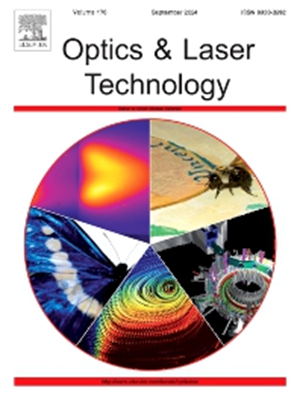IF 4.6
2区 物理与天体物理
Q1 OPTICS
引用次数: 0
摘要
文章深入探讨了耗散系统中的孤子分子这一引人入胜的领域,首先讨论了光纤中孤子的形成及其在可积分模型中的基本动力学。然后,文章介绍了耗散非线性光腔和光纤激光器,它们被誉为研究复杂而迷人的耗散孤子动力学的理想试验平台。这篇综述全面考察了耗散光学动力学研究,包括耗散孤子、孤子分子、复合物和晶体。文章从时空孤子分子和 (3 + 1)D 孤子晶体的非凡发现中,阐明了非线性耗散系统中的光子弹研究。最后,它强调了对孤子分子动力学的深入理解和控制如何在这些引人入胜的光形式中释放出优化 "准智能 "的潜力。在过去和近期突破的基础上,我们提出了 "光机器人"(Photo-bots)的概念--受纳米机器人的启发,在相互作用的孤子和孤子分子中实现智能。纳米机器人是通过物理或化学手段与分子相互作用的物理机器,与之不同的是,光机器人是高度受控和局部化的光,可以在量子层面发挥不可或缺的作用,可以调节原子和分子的量子状态,并有望有其他一些先进的应用。本文章由计算机程序翻译,如有差异,请以英文原文为准。

A review on dissipative optical solitons: A route to photo-bot
The article delves into the intriguing realm of soliton molecules in the dissipative systems where we initially discuss the formation of solitons in optical fibers and their fundamental dynamics within integrable models. It then sheds light on dissipative nonlinear optical cavities and fiber lasers, lauded as ideal testbeds for studying the complex and captivating dynamics of dissipative solitons. The review comprehensively examines research on dissipative optical dynamics, encompassing dissipative solitons, soliton molecules, complexes, and crystals. The article illuminates research on light bullets in nonlinear dissipative systems in the remarkable discovery of spatiotemporal soliton molecules and (3 + 1)D soliton crystals. Finally, it emphasizes how a deep understanding and control over the dynamics of soliton molecules could unlock the potential for optimizing “quasi-intelligence” within these intriguing light formations. Building upon the past and recent breakthroughs, we propose the concept of “Photo-bots” – intelligence in interacting solitons and soliton molecules, inspired by nanobots. In contrast to nanobots, which are physical machines interacting with molecules through physical or chemical means, photo-bots are highly controlled and localized light that could play an indispensable role at the quantum level and can modulate the quantum states of atoms and molecules and promises to have several other advanced applications.
求助全文
通过发布文献求助,成功后即可免费获取论文全文。
去求助
来源期刊
CiteScore
8.50
自引率
10.00%
发文量
1060
审稿时长
3.4 months
期刊介绍:
Optics & Laser Technology aims to provide a vehicle for the publication of a broad range of high quality research and review papers in those fields of scientific and engineering research appertaining to the development and application of the technology of optics and lasers. Papers describing original work in these areas are submitted to rigorous refereeing prior to acceptance for publication.
The scope of Optics & Laser Technology encompasses, but is not restricted to, the following areas:
•development in all types of lasers
•developments in optoelectronic devices and photonics
•developments in new photonics and optical concepts
•developments in conventional optics, optical instruments and components
•techniques of optical metrology, including interferometry and optical fibre sensors
•LIDAR and other non-contact optical measurement techniques, including optical methods in heat and fluid flow
•applications of lasers to materials processing, optical NDT display (including holography) and optical communication
•research and development in the field of laser safety including studies of hazards resulting from the applications of lasers (laser safety, hazards of laser fume)
•developments in optical computing and optical information processing
•developments in new optical materials
•developments in new optical characterization methods and techniques
•developments in quantum optics
•developments in light assisted micro and nanofabrication methods and techniques
•developments in nanophotonics and biophotonics
•developments in imaging processing and systems

 求助内容:
求助内容: 应助结果提醒方式:
应助结果提醒方式:


